
- Index
- Authenticity
- Characteristics
- Genre
- Abstract (93)
- Abstrait (363)
- Art Deco (52)
- Art Déco (109)
- Art Moderne (10)
- Art Naïf (30)
- Art Nouveau (97)
- Cubisme (26)
- Expressionism (54)
- Expressionnisme (162)
- Fauvisme (13)
- Modern (53)
- Moderne (18)
- Naive Art (21)
- Pop Art (40)
- Street Art (62)
- Streetart (87)
- Surrealism (24)
- Surréalisme (103)
- Symbolisme (14)
- Other (1422)
- Style
- Theme
- Abstract (111)
- Animals (32)
- Architecture (3)
- Art (2)
- Calligraphy (2)
- Character (158)
- Erotic Drawings (2)
- Family (2)
- Fantastic (6)
- Flower, Tree (11)
- Genre Scene (9)
- History, War (2)
- Landscape (38)
- Music (6)
- Normandy (3)
- Nude (5)
- Religion, Mythology (7)
- Seascape, Boat (4)
- Sport (2)
- Still Life (8)
- Other (2440)
- Type
Friesz Othon Original Signed Lithograph Numbered/200






Original lithograph, signed in the plate and hand-numbered /200 in pencil. Dry stamp "Atelier Othon-Friesz" in the bottom margin. Condition: see photographs; good; marks from previous framing; margin borders are browned through 5 cm; some humidity spots at the border of the top margin. Paper dimensions: 51.4x37.4 cm; image dimensions: 23.5x17.5 cm. Achille-Émile Othon Friesz, also known as Othon Friesz, was born to a captain.
He studied at the Municipal School of Fine Arts in Le Havre and received a scholarship to enter the School of Fine Arts in Paris. He studied in the studio of Gustave Moreau, but preferred to learn by frequenting the Atelier of Henri Matisse. Initially influenced by the Fauvists, some of his paintings were exhibited at the 1905 Salon d'Automne alongside works by Henri Matisse.
The vibrant colors and energetic drawing style gave the viewer the sensation of entering a "cage aux fauves" (cage of wild beasts), marking the beginning of Fauvism, of which he became one of the representatives. In the summer of 1906, he stayed in Antwerp and worked on similar subjects as his fellow artist, Raoul Dufy. The following year, he traveled to l'Estaque, where he portrayed the light of the South of France on his canvases. Back in Paris, while Georges Braque was developing the foundations of Cubism with Pablo Picasso, whom he had just met, Friesz continued with a naturalistic style influenced by Cézanne. He created landscapes, still lifes, and more traditional seascapes, while still maintaining the energy of his Fauvist period through bold lines, vibrant colors, and strong contrasts. In 1912, he opened his first studio in Normandy.Then, after returning to Paris in 1919, he traveled to the Jura and Italy and began teaching drawing at the Académie de la Grande Chaumière and the Scandinavian Academy painting workshop. In 1937, he decorated the French Pavilion at the World Exposition in Paris.
In addition to his paintings, he produced a large number of lithographs. He had, among others, Marcel Parturier and Jacques Bouyssou as students at the Académie de la Grande Chaumière. From 1914 until his death in 1949, he occupied a studio at 2 bis rue Perrel in Paris, which was later taken over by his student, Jean Aujame. Othon Friesz is buried in Paris at the Montparnasse Cemetery, and his tomb is adorned with a bronze medallion portrait of him.
